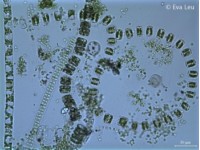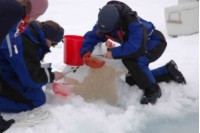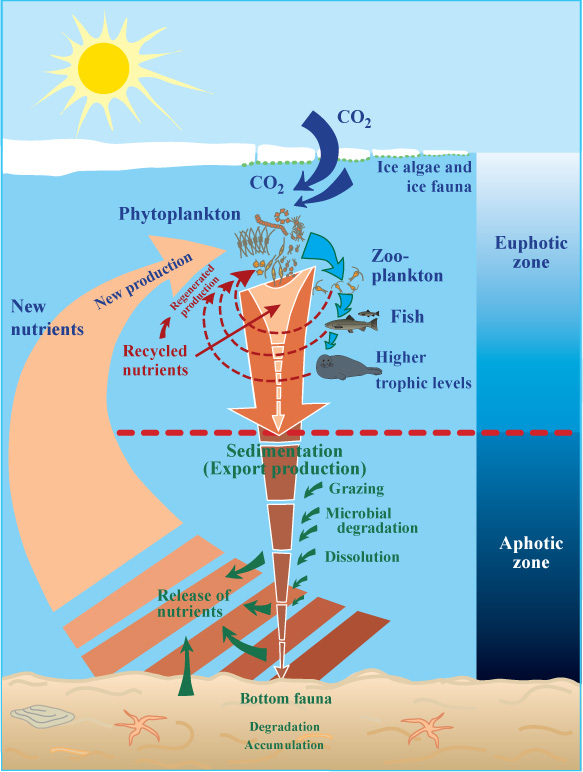Plant life in the sea
 Phytoplankton may look like this through a microscope. The green colour inside the plankton is chlorophyll which the algae use in their photosynthesis. The species of phytoplankton in the photograph, called siliceous algae or diatoms, form long chains. These are single-celled algae. The cell wall is formed of silicic acid and has two shells, making it look like a small box with a lid. Diatom shells are extremely resistant to breakdown. When the diatom dies, its shell is incorporated in the sediment on the sea floor and may be preserved there for many thousands of years.
Illustration: Eva Leu, NPI
Phytoplankton is a collective name for several species of microscopic algae, all of which have chlorophyll and perform photosynthesis. The most important factors controlling the life of phytoplankton are the availability of food in the water and the light.
Phytoplankton may look like this through a microscope. The green colour inside the plankton is chlorophyll which the algae use in their photosynthesis. The species of phytoplankton in the photograph, called siliceous algae or diatoms, form long chains. These are single-celled algae. The cell wall is formed of silicic acid and has two shells, making it look like a small box with a lid. Diatom shells are extremely resistant to breakdown. When the diatom dies, its shell is incorporated in the sediment on the sea floor and may be preserved there for many thousands of years.
Illustration: Eva Leu, NPI
Phytoplankton is a collective name for several species of microscopic algae, all of which have chlorophyll and perform photosynthesis. The most important factors controlling the life of phytoplankton are the availability of food in the water and the light.
Phytoplankton thrive in the upper part of the water because that is where they have best access to the light they need for photosynthesis, but most of them are at the mercy of the circulation in the water as they drift passively around. Owing to the vertical mixing of the water masses, whereby nutrient-rich water from the bottom rises to the surface, access to nutrients varies greatly through the year. Some species spend the winter inside the ice or on the sea floor, but when daylight returns and the sea gets warmer around April, the production of phytoplankton explodes in the waters in and around the Arctic.
The plankton find good living conditions near the edge of the sea ice owing to the favourable alternation between stable water masses and deep vertical mixing where nutrients are brought to the surface. Good production forms the basis for the rich accumulations of fish in the Barents Sea.
 Scientists are taking samples of ice algae growing on the lower side of the ice. The layers of algae may be very thick. These algae require little light to start their production and can begin to bloom several weeks before the freely-living algae begin to stir. Because the ice algae are packed with polyunsaturates, they are nutritious for other animals; they are the feed concentrate of the sea. A research project has shown that ice algae can make up 5-25 % of the food for organisms in the next link in the food chain and as much as 50 % early in the season, before the phytoplankton bloom.
Illustration: Josef Wiktor / Eva Leu, NPI
Ice algae are microscopic algae that live in or on the lower side of the ice. The algae that belong to a sea-ice algal community are recruited from various areas around the ice, such as the sea floor or different levels in the water column. If conditions are appropriate, the algal mats beneath the ice may be several tens of centimetres thick and have algal threads up to several metres in length – a feast for creatures that eat algae.
Scientists are taking samples of ice algae growing on the lower side of the ice. The layers of algae may be very thick. These algae require little light to start their production and can begin to bloom several weeks before the freely-living algae begin to stir. Because the ice algae are packed with polyunsaturates, they are nutritious for other animals; they are the feed concentrate of the sea. A research project has shown that ice algae can make up 5-25 % of the food for organisms in the next link in the food chain and as much as 50 % early in the season, before the phytoplankton bloom.
Illustration: Josef Wiktor / Eva Leu, NPI
Ice algae are microscopic algae that live in or on the lower side of the ice. The algae that belong to a sea-ice algal community are recruited from various areas around the ice, such as the sea floor or different levels in the water column. If conditions are appropriate, the algal mats beneath the ice may be several tens of centimetres thick and have algal threads up to several metres in length – a feast for creatures that eat algae.
Phytoplankton use carbon that comes from the CO2 in the air, and thus help to remove large quantities of CO2 from the atmosphere. Not all the plankton are consumed by other organisms, some die naturally and sink to the bottom where they are buried and thus help to store CO2 for the unforeseeable future. This is one reason why the ocean acts as a gigantic carbon sink (store).
Did you know...
 The length of the day determines when phytoplankton propagate after the dark winter. Laboratory trials show that most species of phytoplankton require at least 12 hours of daylight to propagate. This means that not much plankton growth occurs in the sea until after the spring equinox, 21 March, which is when there is sufficient light.
The length of the day determines when phytoplankton propagate after the dark winter. Laboratory trials show that most species of phytoplankton require at least 12 hours of daylight to propagate. This means that not much plankton growth occurs in the sea until after the spring equinox, 21 March, which is when there is sufficient light.
 The production of planktonic algae begins in earnest when the light returns and conditions uppermost in the water column form a favourable environment for growth. The sun melts the ice and a warmer, less saline, surface layer of water forms above the colder, heavier, underlying layer. The production of phytoplankton can reach the spring peak in this surface layer, and because of the physical stratification of the water masses the biomass (plankton, fish and animals) remains in the euphotic zone (where there is enough light). The plankton production is driven by the availability of nutrients; ”new” nutrients which have been released from the demersal (bottom) community during the winter and from the aphotic zone (where it is dark) become mixed upwards through the water column when the water is agitated during the winter.
The production of planktonic algae begins in earnest when the light returns and conditions uppermost in the water column form a favourable environment for growth. The sun melts the ice and a warmer, less saline, surface layer of water forms above the colder, heavier, underlying layer. The production of phytoplankton can reach the spring peak in this surface layer, and because of the physical stratification of the water masses the biomass (plankton, fish and animals) remains in the euphotic zone (where there is enough light). The plankton production is driven by the availability of nutrients; ”new” nutrients which have been released from the demersal (bottom) community during the winter and from the aphotic zone (where it is dark) become mixed upwards through the water column when the water is agitated during the winter.
Illustration: Wassmann et al. (2006), modified by Frøydis Strand, NFH, University of Tromsø